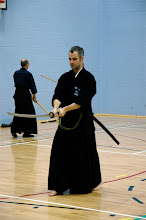So this session we had Chris Sensei back at normal hours and a chance for me and a few others to do some dedicated examination practice. After the normal random ordered seitei run through we divided out and Chris Sensei gave us some briefing on what to work for for the grading. Of particular note is the notion of not leaving the grading panel with a question mark about whether you pass or not. This is a good reason for aiming for one grade above which you are a candidate for.
We all did an embu practice with 5 forms of our own choice and I used Shohatto, Tozume and three seitei. Sensei asked us if we were satisfied with our performance and if so, by how many kata. To be honest I wasn't happy with any of mine as I felt I had rushed through them and couldn't catch up with myself. Shohatto was unstable, Towaki wasn't a big enough initial cut and the seitei disappeard from memory.
We tried again and I swapped Gyakuto into the first kata. Sensei leapt on me and said that my koryu was now too much like my seitei. It was technically correct but the merihari had gone. I thought this might be the case as I was utterly focussed on getting it technically correct but I guess it must have looked robotic. I did it a few more times with a feeling of ebb and flow and he preferred this. If I was to summarise what the final form had as essential criteria I would say that it had to have:
- The ebb and flow of timing and speed to create the merihari
- A certain flourish to show competence and confidence with the technique
- An observation to good shisei even if at parts of the form one is made to lean forwards
Sensei made me do a peer evaluation of my Tozume in front of the others and after a few goes managed to get my posture to become part of the form.
We gradually did more and more practice on various parts of our embu with a special emphasis on my own about maintaining kigurai, that elusive quality that sits somewhere between pride, awareness and keeping a bloody straight back. It was interesting to see the difference it made in Sensei's posture when just standing in Keitoshisei....and I guess this is the point (and the one I try to make to others frequently). Why stand with the hands in such a place that the middle finger touches the side seam of the hakama? It's not the way that most people naturally stand so why do it in Keitoshisei?
I think the direction of thinking is reversed here. We often hear teachers saying "Be natural" and "Do this naturally" but I wonder if sometimes we miss the hidden half of this point, which is this:
Use your training to make good habits a natural part of your body and your movements.
If one stands as naturally up straight in a relaxed posture the hands tend to fall forwards of the thighs. What is this saying? Maybe it's saying that there are a lot of other things wrong with our "natural" (or bad) posture. By forcing oneself to pull the shoulders back slightly, to tighten the stomach muscles and to incline our hips slightly forwards, maybe our posture is improved as the fingers certainly naturally find their way to the side seams.
It's a long shot but a fairly logical one. Once cannot afford to be too natural if one is naturally "bad". Sometimes the learning of new and good habits brings a new and improved natural.





First of all, very interesting post!
ReplyDeleteIn my opinion maybe the "be natural" reinforcement means to "find your own way" through training.
Here's what I think of it all..
Knowing that everyone is different in many aspects such as timing, thought, feeling, awareness and growth, everyone will differ in their outcome from each training even if they attend the same training sessions and do the same exercises over and over.
Supposably after a lot of training the techniques become part of the individual or group's body to a point where it is recognizable from dojo to dojo.
This is when distinction easily arises.
For example, if two pictures are "exactly" the same but give off a different feeling are they still the same picture to you?!
In the same kind of logic, one should try to attain the tech-perfection as well as that projection of self-being. The natural feel.
Suffice to say that "the way is in training"(M.Musashi), so one should learn all the ways to finally grasp a meaningful understanding of what they find their own way to be. And know it to be.
Keep it up!
Cheers